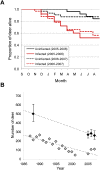Lions and prions and deer demise
- PMID: 19107193
- PMCID: PMC2602978
- DOI: 10.1371/journal.pone.0004019
Lions and prions and deer demise
Abstract
Background: Contagious prion diseases--scrapie of sheep and chronic wasting disease of several species in the deer family--give rise to epidemics that seem capable of compromising host population viability. Despite this prospect, the ecological consequences of prion disease epidemics in natural populations have received little consideration.
Methodology/principal findings: Using a cohort study design, we found that prion infection dramatically lowered survival of free-ranging adult (>2-year-old) mule deer (Odocoileus hemionus): estimated average life expectancy was 5.2 additional years for uninfected deer but only 1.6 additional years for infected deer. Prion infection also increased nearly fourfold the rate of mountain lions (Puma concolor) preying on deer, suggesting that epidemics may alter predator-prey dynamics by facilitating hunting success. Despite selective predation, about one fourth of the adult deer we sampled were infected. High prevalence and low survival of infected deer provided a plausible explanation for the marked decline in this deer population since the 1980s.
Conclusion: Remarkably high infection rates sustained in the face of intense predation show that even seemingly complete ecosystems may offer little resistance to the spread and persistence of contagious prion diseases. Moreover, the depression of infected populations may lead to local imbalances in food webs and nutrient cycling in ecosystems in which deer are important herbivores.
Conflict of interest statement
Figures



References
-
- Hornlimann B, Riesner D, Kretzschmar H, editors. Prions in Humans and Animals. Walter de Gruyter. 2006:714.
-
- Detwiler LA, Baylis M. The epidemiology of scrapie. Rev sci tech Off int Epiz. 2003;22:121–143. - PubMed
-
- Williams ES, Young S. Chronic wasting disease of captive mule deer: a spongiform encephalopathy. J Wildl Dis. 1980;16:89–98. - PubMed
-
- Williams ES. Chronic wasting disease. Vet Path. 2005;42:530–549. - PubMed
Publication types
MeSH terms
LinkOut - more resources
Full Text Sources

